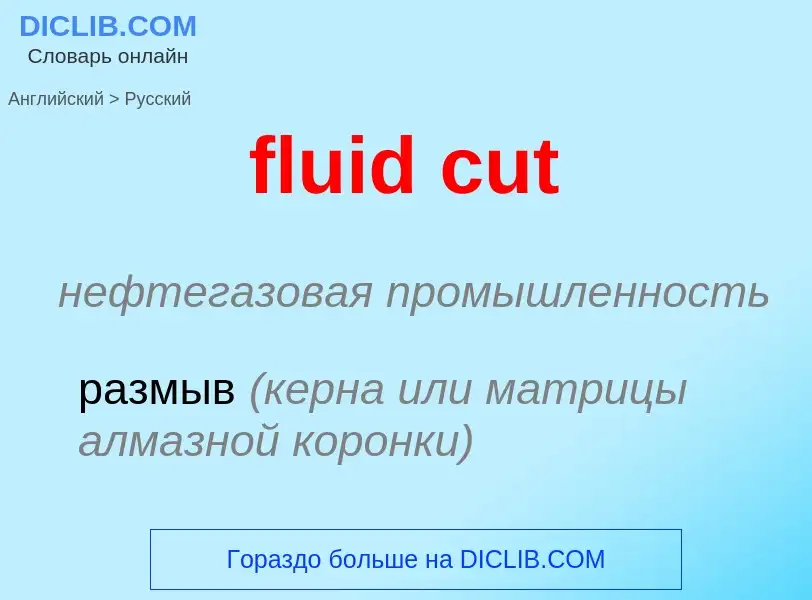Translation and analysis of words by ChatGPT artificial intelligence
On this page you can get a detailed analysis of a word or phrase, produced by the best artificial intelligence technology to date:
- how the word is used
- frequency of use
- it is used more often in oral or written speech
- word translation options
- usage examples (several phrases with translation)
- etymology
fluid cut - translation to russian
нефтегазовая промышленность
размыв (керна или матрицы алмазной коронки)
['kʌtiŋ'flu:d]
общая лексика
жидкость смазочно-охлаждающая
техника
смазочно-охлаждающая жидкость
существительное
общая лексика
граненое стекло
Definition
Wikipedia

Ferrofluid is a liquid that is attracted to the poles of a magnet. It is a colloidal liquid made of nanoscale ferromagnetic or ferrimagnetic particles suspended in a carrier fluid (usually an organic solvent or water). Each magnetic particle is thoroughly coated with a surfactant to inhibit clumping. Large ferromagnetic particles can be ripped out of the homogeneous colloidal mixture, forming a separate clump of magnetic dust when exposed to strong magnetic fields. The magnetic attraction of tiny nanoparticles is weak enough that the surfactant's Van der Waals force is sufficient to prevent magnetic clumping or agglomeration. Ferrofluids usually do not retain magnetization in the absence of an externally applied field and thus are often classified as "superparamagnets" rather than ferromagnets.
In contrast to ferrofluids, magnetorheological fluids (MR fluids) are magnetic fluids with larger particles. That is, a ferrofluid contains primarily nanoparticles, while an MR fluid contains primarily micrometre-scale particles. The particles in a ferrofluid are suspended by Brownian motion and generally will not settle under normal conditions, while particles in an MR fluid are too heavy to be suspended by Brownian motion. Particles in an MR fluid will therefore settle over time because of the inherent density difference between the particles and their carrier fluid. As a result, ferrofluids and MR fluids have very different applications.
A process for making a ferrofluid was invented in 1963 by NASA's Steve Papell to create liquid rocket fuel that could be drawn toward a fuel pump in a weightless environment by applying a magnetic field. The name ferrofluid was introduced, the process improved, more highly magnetic liquids synthesized, additional carrier liquids discovered, and the physical chemistry elucidated by R. E. Rosensweig and colleagues. In addition Rosensweig evolved a new branch of fluid mechanics termed ferrohydrodynamics which sparked further theoretical research on intriguing physical phenomena in ferrofluids. In 2019, researchers at the University of Massachusetts and Beijing University of Chemical Technology succeeded in creating a permanently magnetic ferrofluid which retains its magnetism when the external magnetic field is removed. The researchers also found that the droplet's magnetic properties were preserved even if the shape was physically changed or it was divided.


![[[Macrophotograph]] of ferrofluid influenced by a magnet. [[Macrophotograph]] of ferrofluid influenced by a magnet.](https://commons.wikimedia.org/wiki/Special:FilePath/Ferrofluid close.jpg?width=200)
![A ferrofluid in a [[magnetic field]] showing normal-field instability caused by a [[neodymium magnet]] beneath the dish A ferrofluid in a [[magnetic field]] showing normal-field instability caused by a [[neodymium magnet]] beneath the dish](https://commons.wikimedia.org/wiki/Special:FilePath/Ferrofluid in magnetic field.jpg?width=200)

.jpg?width=200)


.jpg?width=200)
.gif?width=200)
![Chandelier in the chapel of [[Emmanuel College, Cambridge]], donated in 1732, one of the earliest datable cut glass examples. The shape follows contemporary brass examples, with glass branches but no "drops"; only the pieces down the stem are cut, mostly with flat facets.<ref>Battie & Cottle, 102</ref> Chandelier in the chapel of [[Emmanuel College, Cambridge]], donated in 1732, one of the earliest datable cut glass examples. The shape follows contemporary brass examples, with glass branches but no "drops"; only the pieces down the stem are cut, mostly with flat facets.<ref>Battie & Cottle, 102</ref>](https://commons.wikimedia.org/wiki/Special:FilePath/Emmanuel College Chapel 2, Cambridge, UK - Diliff (cropped).jpg?width=200)
![American "brilliant cut" [[punch bowl]] on stand, 1895 American "brilliant cut" [[punch bowl]] on stand, 1895](https://commons.wikimedia.org/wiki/Special:FilePath/Punch Bowl on Stand LACMA M.91.320.6.jpg?width=200)
![Montgolfier]]" shape (due to its resemblance to an inverted [[hot air balloon]]),<ref>History</ref> in [[Edinburgh]] Montgolfier]]" shape (due to its resemblance to an inverted [[hot air balloon]]),<ref>History</ref> in [[Edinburgh]]](https://commons.wikimedia.org/wiki/Special:FilePath/Royal Lyceum Edinburgh Chandelier.jpg?width=200)
![Regency]] chandeliers in [[Saltram House]], England Regency]] chandeliers in [[Saltram House]], England](https://commons.wikimedia.org/wiki/Special:FilePath/The Saloon (7279934644).jpg?width=200)
![[[Waterford Crystal]] factory in 2001 [[Waterford Crystal]] factory in 2001](https://commons.wikimedia.org/wiki/Special:FilePath/Waterford Crystal tour - Quality control - geograph.org.uk - 1636581.jpg?width=200)
![engraving]] above, England, late 18th-century engraving]] above, England, late 18th-century](https://commons.wikimedia.org/wiki/Special:FilePath/Wine Rinser (England), 18th century (CH 18464757-2) (cropped).jpg?width=200)


, 1760–80 (CH 18621563) (cropped).jpg?width=200)
.jpg?width=200)
, early 19th century (CH 18621221).jpg?width=200)
, ca. 1835 (CH 18621547) (cropped).jpg?width=200)
